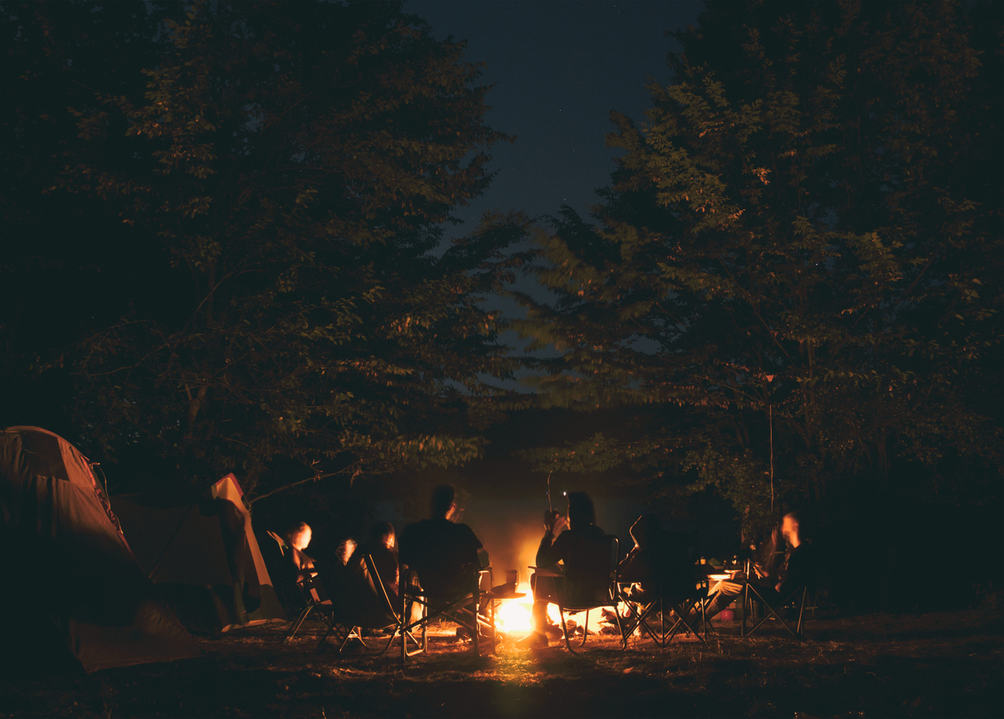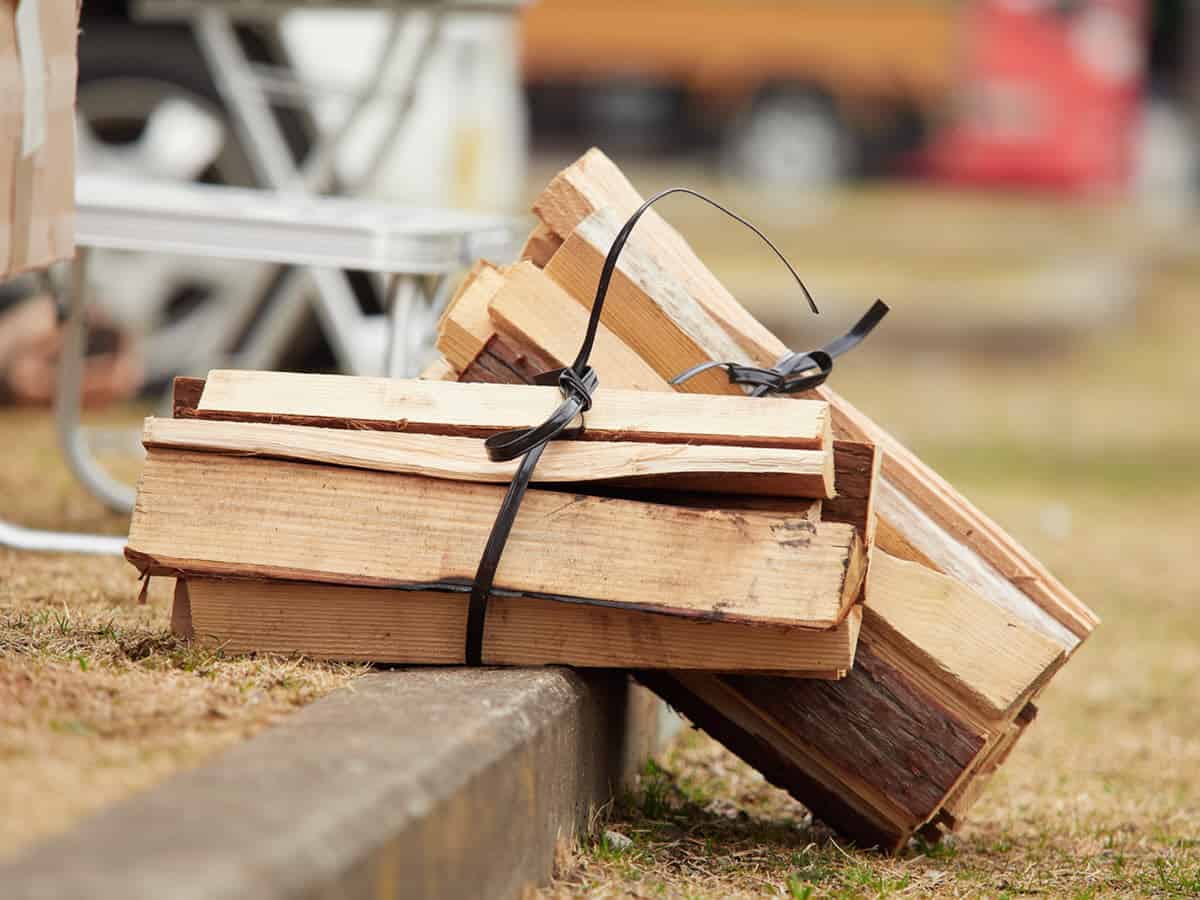Finding cheap firewood for camping doesn’t have to be a challenge, with numerous budget-friendly options available to fuel your outdoor adventures.
While campsite bundles typically cost between $5 to $10, savvy campers can significantly reduce this expense by exploring local sources, timing their purchases strategically, and maximizing their firewood usage.
Whether planning a weekend getaway or an extended camping trip, these proven methods will help you keep your campfire burning without burning through your wallet.
Keep reading—it’s easier than you think!
Key Takeaways
- Look for local wood sellers near campgrounds; they often sell firewood at lower prices than big stores.
- Ask friends and family if they know someone with extra wood, or visit online marketplaces like Facebook Marketplace for good deals. But be aware of environmental risks.
- Check with local businesses, such as construction sites or cabinet shops, for free scrap wood that can be used as firewood.
- Home improvement stores like Lowe’s and Home Depot sell bulk firewood that’s ideal for camping, sometimes offering unseasoned wood at a discount.
- Use a small camping stove to save on firewood and plan your needs carefully—about two bundles per night should work for a moderate campfire.
Top 5 Places to Find Cheap Firewood for Camping

Venturing into the great outdoors doesn’t mean you have to spend a fortune keeping warm by the campfire. Clever campers know there’s an array of spots to snag that all-important cheap firewood, and we’re lighting the way to five must-check locales for fueling your flames without burning through your wallet.
Local wood sellers near campgrounds
Campers often find the best deals on firewood right by their campsites. Local wood sellers usually set up shop near campgrounds, knowing that campers need wood for fires. These sellers offer bundles of wood at prices lower than big stores.
It’s a win-win situation: you get your cheap firewood, and they make a sale close to home.
Before heading out, look for local advertisements or signs pointing to these wood sellers. They might have seasoned wood ready to burn or green wood that’s cheaper but needs time to dry out.
Buying in larger quantities can lead to better deals, so consider pooling with fellow campers if you don’t need a lot yourself. This way, everyone enjoys the warmth of a fire without burning through their wallets!
Seasonal Timing for Better Deals
Smart campers know timing matters when hunting for cheap firewood. Prices typically drop in late spring and early summer when demand is low. Many suppliers offer discounts to clear inventory before the next cutting season begins.
Consider stocking up during these off-peak times if you have proper storage space. Some wood sellers slash prices by 30-50% during these periods compared to peak camping season rates. Just make sure you store your wood in a dry, elevated location to prevent moisture damage and pest infestation.
For last-minute trips, try visiting wood sellers on Sunday evenings when they’re more likely to offer discounts rather than haul unsold inventory back home.
Friends and family
Friends and family can be your secret weapon for finding cheap firewood. They might know someone with extra wood they’re willing to share or sell at a low cost. Plus, gathering wood together can turn into fun outings in national forests where collecting fallen timber is legal.
Just make sure you all respect the local ecosystem by not disturbing live trees and habitats.
You could also team up for a scavenger hunt after other campers leave their sites. Look for leftover pieces they didn’t use; just watch out for invasive species like the emerald ash borer or walnut twig beetle hitching a ride on your found wood.
And always check if collecting is okay — some places have rules against taking wood from certain areas to protect against bugs like the brown marmorated stink bug harming the woods.
Local businesses with scrap wood
Local businesses often toss out scrap wood. This could be your chance to grab some firewood for your camping trip. Look for places like construction sites or lumber yards. They may have leftovers they’re willing to give away or sell at a low price.
Some types of wood from these spots, like oak and ash trees, burn longer and hotter—perfect for campfires.
Carpenters and cabinet shops also end up with lots of extra wood pieces. Swing by and ask if they have any scraps you can take off their hands. Even though this might include softer woods or unseasoned lumber, it’s still good for a quick bonfire blaze or as kindling to start your fires.
Just make sure the wood is safe to burn—avoid any that’s been treated with chemicals.
Before heading online to check out marketplaces..
Online marketplaces
Online marketplaces are a hot spot for scoring cheap firewood. These platforms let you browse through various types and quantities of wood from the comfort of your home. Think Facebook Marketplace, where sellers post what they have on offer.
You might find someone local who’s just finished splitting wood and has too much on their hands.
The best part is comparing prices across different sellers without having to drive around town. Many sellers might even throw in delivery at a good price, making your camping prep way easier.
Once you’ve clicked purchase, you can focus on other trip details like gathering hardwoods for that perfect campfire or picking up a reliable fire starter from Home Depot.
Now, let’s consider how the cost of firewood can vary when planning your camping budget..
Home improvement stores
Moving from online options, let’s talk about a more traditional route—home improvement stores. They’re great spots to buy firewood in bulk for your camping trip. Places like Lowe’s or Home Depot offer cords or fractions of cords that you can stock up on.
Keep them in your backyard, shed, or garage until it’s time to hit the campsite. These stores often have harder woods that burn slower and give off more heat—perfect for those chilly nights under the stars.
At these home improvement giants, you might also find deals on unseasoned wood, which is less expensive than kiln-dried alternatives. Just remember that unseasoned wood needs time to dry out before you can use it effectively in a campfire.
You’ll avoid smoke problems and get better flames this way! And don’t worry about pests; these stores ensure their wood is clean and free from parasites, so nothing unwanted will tag along on your camping adventure.
Environmental Considerations
The Environmental Risks of Moving Firewood
Before moving on to other sources, let’s talk about some potential environmental problems with transporting wood to your campsite.
While it may seem harmless to bring along firewood from home on your next camping trip, transporting firewood can actually have devastating effects on the environment. Invasive pests and diseases often hitch a ride on firewood, spreading to new areas and wreaking havoc on local ecosystems.
Insects like the Asian longhorned beetle, emerald ash borer, and gypsy moth can burrow deep into cut firewood, laying eggs that go undetected to the human eye. When infested firewood is moved to a new location, these pests emerge and attack trees around the campsite. Diseases such as oak wilt and sudden oak death can also spread through contaminated firewood.
Native trees have not evolved defenses against these foreign threats. As a result, invasive species can quickly kill trees and forever alter forest habitats. Transporting just a few logs of infested firewood is enough to spark a new devastating outbreak.
To protect our forests, many states have laws restricting the movement of untreated firewood. The general rule is to not move firewood more than 50 miles from its source. The safest approach is to buy firewood near your destination, or gather it on-site when permitted. Always leave leftover wood behind – don’t bring it back home or to your next campground.
By using local firewood, you can enjoy a cozy campfire while preserving the health of our nation’s forests for generations to come.
The Four D’s of Responsible Collection
When collecting firewood in areas where it’s permitted, follow the “Four D’s” principle:
- Dead: Only collect dead wood, leaving living trees untouched.
- Down: Use wood that’s already on the ground, not standing dead trees.
- Dinky: Choose wood about the size of your wrist or smaller.
- Distant: Gather wood over a large area to minimize localized impact.
This approach helps protect habitats, soil nutrients, and the overall ecosystem. Remember that in some areas, collecting any firewood may be prohibited to preserve the environment.
Know the Rules Before Gathering Firewood
Before heading out to collect firewood for your next camping trip, it’s crucial to understand the regulations in place to protect forest health. Rules can vary depending on the location and agency managing the land.
On most U.S. Forest Service and Bureau of Land Management lands, you are allowed to gather dead and down wood for campfires without a permit, as long as it’s for personal use. However, there are often restrictions on the size and amount of wood you can take. For example, in Coconino National Forest, wood must be less than 12 inches in diameter and 4 feet in length.
If you want to collect larger quantities of firewood to take home, a permit is typically required. These low-cost permits, such as the $20 ones offered in Michigan state forests, allow you to gather a set volume of wood, like 5 cords, from designated areas.
In some popular camping destinations, like state parks, gathering any firewood may be prohibited to preserve the ecosystem. Dead logs and branches provide vital habitat and nutrients. It’s best to buy bundled firewood near your campsite or from the camp host in these cases.
Transporting firewood across state lines or outside of a certain radius, often 50 miles, is also commonly restricted to prevent the spread of invasive pests. So, even if you legally gather wood, don’t plan on taking it back home with you.
The key is to always check the specific regulations for your camping location in advance. Look up the rules online, contact a ranger station, or ask the campground host. By following the guidelines, you can enjoy a cozy campfire while being a responsible steward of our forests.
Factors Affecting the Cost of Firewood for Camping

The price of firewood can swing up or down for several reasons. One major factor is the wood type; hardwoods like oak burn slowly and give off more heat, but they cost more than softer woods like pine.
Season also plays a big role – during winter months, everyone wants to stay warm, so firewood prices go up because demand is high. If you’re camping in a place far from where trees grow, expect to pay extra for transport costs.
Local laws are important, too; some areas have restrictions on moving firewood to prevent the spreading of tree diseases and pests, which can affect availability and price.
Another thing to keep in mind is how much wood you actually need. Buying in bulk often leads to better deals per bundle compared to getting small amounts as needed. However, don’t buy too much! Too much left-over wood becomes clutter or goes wasted if it’s not stored properly and gets wet or rots away before your next trip into the great outdoors.
Efficient Use of Firewood During Camping
Maximizing your firewood supply while camping isn’t just about finding the cheapest source—it’s also about using what you have wisely. Whether it’s mastering the art of a perfectly sized campfire or gauging how much wood you’ll actually need for the duration of your trip, there are strategies to make every log count..
Using a small camping stove
A small camping stove is a great tool for saving firewood. You use less wood, and your fire burns longer. Think about how much time you’ll be sitting by the campfire. This helps you figure out how many bundles of wood to get.
Bring a small stove on your trip to keep things simple. It makes cooking easier, too! Plus, it’s good for the environment because it cuts down on the amount of wood used. You’re doing your part to protect nature while enjoying the outdoors.
Quick Tip: See How to Use a Camping Stove.
Estimating the required amount
Experienced campers often report using 3-4 bundles for a full day of camping with morning and evening fires. For a three-night camping trip, you might need 9-12 bundles total if you plan to have fires consistently.
Consider your specific needs when estimating:
- Morning fires (typically smaller): 1 bundle
- Evening fires (longer duration): 2-3 bundles
- Cold weather camping: Add 1 extra bundle per day
- Cooking-focused fires: 1 dedicated bundle
Planning accurately helps avoid both running out of wood and overspending on supplies you won’t use.
Cost-Effective Firewood Types
Not all firewood burns the same way or costs the same amount. Hardwoods like oak and maple burn longer and hotter but typically cost more than softwoods like pine and cedar.
For budget-conscious campers, consider a mixed approach. Use less expensive softwoods for getting your fire started and maintaining it during cooking, then add a few pieces of hardwood for longer-lasting evening warmth. This strategy can reduce your overall firewood expenses by 20-30% while still providing an enjoyable campfire experience.
Avoid wood types that produce excessive smoke or sparks, such as pine with high resin content, as these can be problematic at crowded campgrounds and may violate fire safety regulations.
Conclusion
Conclusion: Fueling Your Campfire Without Burning Your Budget
Finding cheap firewood for camping is an achievable goal with a bit of planning and resourcefulness. By exploring local sources, timing your purchases strategically, and using wood efficiently, you can keep your campfire burning bright without emptying your wallet.
Remember these key takeaways:
- Local sellers near campgrounds often offer better deals than big stores
- Seasonal timing can lead to significant discounts, especially in late spring and early summer
- Online marketplaces and community resources can be goldmines for affordable firewood
- Efficient use of wood, including supplementing with a camping stove, stretches your supply further
- Always prioritize environmental responsibility by following local regulations and the “Four D’s” principle when collecting wood
With these strategies in mind, you’re well-equipped to enjoy the warmth and ambiance of a campfire without overspending. So gather round, toast some marshmallows, and relish in the satisfaction of your savvy firewood sourcing skills on your next camping adventure.
Quick Tip: It’s good to know How To Make Fire With Sticks, just in case!
FAQs
How can I tell if my firewood is dry enough to burn?
The easiest way is to knock two pieces together—if you hear a sharp crack, you’re good to go. Dry wood also feels lighter than you’d expect, and you’ll often see cracks at the ends. If it smells fresh or feels damp, it probably needs more time to dry out.
What’s the best way to keep my firewood dry at camp?
Keep your woodpile off the ground—use rocks, a log, or even your cooler. Toss a tarp or rain jacket over the top if rain’s coming, but leave the sides open so air can move through. If you’re expecting a real downpour, stash a few pieces under your car or tent vestibule for emergencies.
Are there eco-friendly alternatives to firewood for camping?
Absolutely! You can try compressed sawdust logs or even bioethanol fuel, which burns clean and doesn’t leave ash. Some folks bring a portable propane fire pit—no wood needed, and it’s allowed during some fire bans. Solar-powered lanterns can also give you that cozy glow without burning anything.
Any tricks for making my fire last longer without burning through all my wood?
Yes! Start with a small, hot fire instead of a big one. Stack your logs in a “log cabin” or “teepee” shape so air can move through. Once you’ve got a good bed of coals, add hardwoods if you have them—they burn slower and hotter. And don’t forget: a fire reflector (just a wall of rocks or logs behind your fire) will bounce heat back toward you, so you stay warm with less fuel.
What should I do with leftover firewood when I’m packing up?
If you bought the wood near camp, leave any extras stacked neatly for the next camper. Don’t haul it home—moving firewood can spread pests and diseases to new places. If you collected it on-site, scatter any unused pieces back where you found them.
What are some clever ways to use firewood at camp besides just burning it?
Firewood isn’t just for fires! Use a sturdy log as a makeshift stool or table, or build a cooking platform by stacking a few logs and laying your grill grate on top. If you’re feeling crafty, carve a walking stick or even make a rustic lantern by hollowing out a chunk of wood and popping in a candle or LED light.
What’s a quick way to start a fire if I’m running low on kindling?
If you’re short on kindling, look for dry pine needles, birch bark, or even pocket lint—they all catch a spark fast. You can also make “feather sticks” by shaving thin curls into a dry stick with your knife. Build your fire in a teepee shape, and light the tinder in the middle for the best results.

Leave a Reply